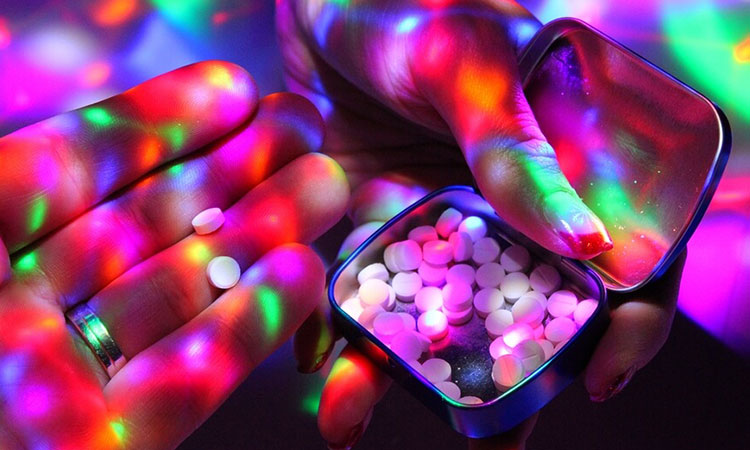
Ecstasy has a half-life around 7 hours, then it would take about 1.5 to 2 days for ecstasy to be eliminated from a person’s system. The recreational effects of ecstasy usually last from 3 to 6 hours. However, this can vary based on several factors.
Recreational Effects and Metabolism
When used recreationally, the user often feels energetic, euphoric, and highly sexual. Ecstasy is commonly used as a party drug among young people in social scenes such as bars, clubs, concerts, raves, festivals, etc.
Other party/club drugs include, but are not limited to ketamine (Special K), GHB, Rohypnol (Roofies), methamphetamine, amyl nitrate (poppers), 2C-B, LSD, and hallucinogenic mushrooms.
Ecstasy is a unique drug in that it results in effects similar to those of amphetamines as well as hallucinogens.
Studies have found that MDMA taken orally reaches the maximum blood concentration in around two hours. At this time users may feel peak effects. Over time, ecstasy is metabolized and broken down into the urine. Using a urinalysis test, these metabolites can still be detected in a person’s system for up to two days.
Because Ecstasy has a relatively short half-life, people may use more of the drug as the euphoria wears off. Although rare, taking doses of Ecstasy in quick succession has been linked to heart problems, dehydration, and overdose.
Using Ecstasy With Other Drugs and Overdose

Using Ecstasy with other substances can be particularly dangerous for a few different reasons. For one, MDMA is illegal and not regulated by the government as a standard dose.
As an illicit drug, is it not manufactured or packaged according to any specifications and tablets/capsules can include other drugs or toxic ingredients. On average, however, a dose of Ecstasy dose usually falls somewhere between 10 mg and 150 mg. People who have used MDMA for an extended period – say over a long night of partying – may have ingested an amount equal to 700 mg or more.
When higher doses are consumed, the risk of mixing MDMA with other drugs and alcohol becomes even greater.
Pills sold illicitly as Molly or Ecstasy have a high risk of containing other psychoactive substances. For example, drugs sold as pure MDMA have been found to contain bath salts, cocaine, ketamine, and even methamphetamine.
Researchers who have examined the chemical compounds present in MDMA have found that results widely vary. Molly, the crystal powder form of MDMA sold in capsules. One study found that nearly half of all Molly users who thought they were getting pure MDMA tested positive for synthetic cathinone, commonly known as bath salts.
In recent news, star of the television show “Storm Chasers” Joel Taylor died in January on a cruise. The toxicology report later deemed the cause of his death to be Ecstasy, although he had other drugs, including traces of ketamine and Ambien in his system.
Variation in Effects
Because Ecstasy or MDMA drugs probably have other substances combined with them, this fact also impacts the timeline for Ecstasy’s effects, metabolism rate, and half-life.
Other than dosage (frequency and duration) factors that determine how quickly and efficiently a drug is metabolized include age, height/weight, genetics, and overall health.
Adverse Effects
Long after an Ecstasy high has worn off, unpleasant side effects can persist for as long as 24 hours.
These include but are not limited to the following:
- Nausea
- Vision problems (blurred vision or light sensitivity)
- Dry mouth
- Muscle cramping or tension
- Uncontrollable jaw and/or teeth clenching (bruxism)
- Sweating
According to the National Institute of Drug Abuse (NIDA), some of ecstasy’s most undesirable adverse effects may last up to 7 days and include:
- Irritability
- Impulsiveness and aggression
- Depression
- Sleep disturbances
- Anxiety
- Memory and attention problems
- Decreased appetite
- Decreased libido
- Dangerous spikes in body temperature that can lead to failure of major organs and death
Treatment for Ecstasy Abuse

Treatment for the abuse of any drug often begins with a medically-assisted detox. During this process, clinicians oversee the patient, monitor withdrawal effects and vital signs, and administer medication as appropriate.
After the body has cleared itself of toxins, patients are encouraged to undergo an intensive addiction treatment program at our center. Our programs include both partial hospitalization and outpatient formats and feature evidence-based services such as individual and group therapy and counseling, 12-step programs, music and art therapy, and more.
After formal treatment has been completed, patients can continue to foster their recovery by engaging in our aftercare program and participating in alumni activities.
Our programs are structured with various components of evidence-based treatment practices and holistic approaches to treatment that provide our patients with the knowledge and tools they need to be successful in their recovery.
Our Approach To Addiction Treatment
We provide a comprehensive, holistic method to treatment, encompassing a wide array of different evidence-based practices in combination. All of Midwood Addiction Treatment’s primary therapists are either licensed or master’s level clinicians.
Our programs are structured with various components of evidence-based treatment practices and holistic approaches to treatment that provide our patients with the knowledge and tools they need to be successful in their recovery.
If you or your loved one is suffering from substance abuse, please seek help as soon as possible.
Call us now to learn about our treatment options.
READ THIS NEXT: Adderall Side Effects